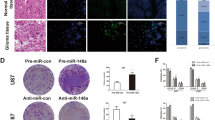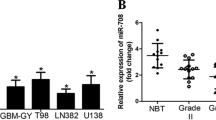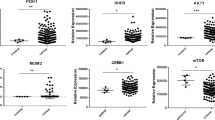Abstract
Although increasing evidence indicated that the deregulation of microRNAs (miRNAs) contributes to tumorigenesis and invasion, little is known about the role of miR-637 in human gliomas. In the present study, we found that the expression level of miR-637 was significantly reduced in clinical glioma tissues compared with normal brain tissues. Moreover, we revealed that the introduction of miR-637 dramatically suppressed glioma cell growth, migration and invasion in vitro and in vivo. Further studies revealed that Akt1 is a direct target gene of miR-637. Silencing of Akt1 inhibited the growth and invasion of glioma cells by decreasing phosphorylated Akt, β-catenin, phosphorylated Foxo1 and Cyclin D1 and inducing the expression of Foxo1, which was consistent with the effect of miR-637 overexpression. Suppressed expression of miR-637 and increased Akt1 protein levels were correlated with unfavorable progression and poor prognosis, respectively, and a negative relationship between the miR-637 expression and Akt1 protein levels was observed in gliomas. Our findings provide new insights into the role of miR-637 in the development of gliomas, and implicate the potential application of miR-637 in cancer therapy.
This is a preview of subscription content, access via your institution
Access options
Subscribe to this journal
Receive 50 print issues and online access
$259.00 per year
only $5.18 per issue
Buy this article
- Purchase on Springer Link
- Instant access to full article PDF
Prices may be subject to local taxes which are calculated during checkout








Similar content being viewed by others
References
Maher EA, Furnari FB, Bachoo RM, Rowitch DH, Louis DN, Cavenee WK et al. Malignant glioma: genetics and biology of a grave matter. Genes Dev 2001; 15: 1311–1333.
Emdad L, Dent P, Sarkar D, Fisher PB . Future approaches for the therapy of malignant glioma: targeting genes mediating invasion. Future Oncol 2012; 8: 343–346.
Lefranc F, Brotchi J, Kiss R . Possible future issues in the treatment of glioblastomas: special emphasis on cell migration and the resistance of migrating glioblastoma cells to apoptosis. J Clin Oncol 2005; 23: 2411–2422.
Stupp R, Hegi ME, Mason WP, van den Bent MJ, Taphoorn MJ, Janzer RC et al. Effects of radiotherapy with concomitant and adjuvant temozolomide versus radiotherapy alone on survival in glioblastoma in a randomised phase III study: 5-year analysis of the EORTC-NCIC trial. Lancet Oncol 2009; 10: 459–466.
Jansen M, Yip S, Louis DN . Molecular pathology in adult gliomas: diagnostic, prognostic, and predictive markers. Lancet Neurol 2010; 9: 717–726.
Hobert O . miRNAs play a tune. Cell 2007; 131: 22–24.
Bartel DP . MicroRNAs: target recognition and regulatory functions. Cell 2009; 136: 215–233.
Quintavalle C, Garofalo M, Zanca C, Romano G, Iaboni M, del Basso De Caro M et al. miR-221/222 overexpession in human glioblastoma increases invasiveness by targeting the protein phosphate PTPmu. Oncogene 2012; 31: 858–868.
Yin D, Ogawa S, Kawamata N, Leiter A, Ham M, Li D et al. miR-34a functions as a tumor suppressor modulating EGFR in glioblastoma multiforme. Oncogene 2013; 32: 1155–1163.
Parsons DW, Jones S, Zhang X, Lin JC, Leary RJ, Angenendt P et al. An integrated genomic analysis of human glioblastoma multiforme. Science 2008; 321: 1807–1812.
Fang L, Deng Z, Shatseva T, Yang J, Peng C, Du WW et al. MicroRNA miR-93 promotes tumor growth and angiogenesis by targeting integrin-beta8. Oncogene 2011; 30: 806–821.
Wu S, Lin Y, Xu D, Chen J, Shu M, Zhou Y et al. MiR-135a functions as a selective killer of malignant glioma. Oncogene 2012; 31: 3866–3874.
Dontula R, Dinasarapu A, Chetty C, Pannuru P, Herbert E, Ozer H et al. MicroRNA 203 modulates glioma cell migration via Robo1/ERK/MMP-9 signaling. Genes Cancer 2013; 4: 285–296.
Besse A, Sana J, Fadrus P, Slaby O . MicroRNAs involved in chemo- and radioresistance of high-grade gliomas. Tumour Biol 2013; 34: 1969–1978.
Zhang B, Pan X, Cobb GP, Anderson TA . microRNAs as oncogenes and tumor suppressors. Dev Biol 2007; 302: 1–12.
Nan Y, Han L, Zhang A, Wang G, Jia Z, Yang Y et al. MiRNA-451 plays a role as tumor suppressor in human glioma cells. Brain Res 2010; 1359: 14–21.
Guo P, Lan J, Ge J, Nie Q, Mao Q, Qiu Y . miR-708 acts as a tumor suppressor in human glioblastoma cells. Oncol Rep 2013; 30: 870–876.
Zhang JF, He ML, Fu WM, Wang H, Chen LZ, Zhu X et al. Primate-specific microRNA-637 inhibits tumorigenesis in hepatocellular carcinoma by disrupting signal transducer and activator of transcription 3 signaling. Hepatology 2011; 54: 2137–2148.
Leivonen SK, Sahlberg KK, Makela R, Due EU, Kallioniemi O, Borresen-Dale AL et al. High-throughput screens identify microRNAs essential for HER2 positive breast cancer cell growth. Mol Oncol 2013; 8: 93–104.
Stokowy T, Wojtas B, Fujarewicz K, Jarzab B, Eszlinger M, Paschke R . miRNAs with the potential to distinguish follicular thyroid carcinomas from benign follicular thyroid tumors: results of a meta-analysis. Horm Metab Res 2014; 46: 171–180.
Li GQ, Zhang Y, Liu D, Qian YY, Zhang H, Guo SY et al. PI3 kinase/Akt/HIF-1alpha pathway is associated with hypoxia-induced epithelial-mesenchymal transition in fibroblast-like synoviocytes of rheumatoid arthritis. Mol Cell Biochem 2013; 372: 221–231.
Wlodarski P, Grajkowska W, Lojek M, Rainko K, Jozwiak J . Activation of Akt and Erk pathways in medulloblastoma. Folia Neuropathol 2006; 44: 214–220.
Schlegel J, Piontek G, Budde B, Neff F, Kraus A . The Akt/protein kinase B-dependent anti-apoptotic pathway and the mitogen-activated protein kinase cascade are alternatively activated in human glioblastoma multiforme. Cancer Lett 2000; 158: 103–108.
Wang Y, Wang X, Zhang J, Sun G, Luo H, Kang C et al. MicroRNAs involved in the EGFR/PTEN/AKT pathway in gliomas. J Neurooncol 2012; 106: 217–224.
Schmidt M, Fernandez de Mattos S, van der Horst A, Klompmaker R, Kops GJ, Lam EW et al. Cell cycle inhibition by FoxO forkhead transcription factors involves downregulation of cyclin D. Mol Cell Biol 2002; 22: 7842–7852.
Cai N, Wang YD, Zheng PS . The microRNA-302-367 cluster suppresses the proliferation of cervical carcinoma cells through the novel target AKT1. RNA 2013; 19: 85–95.
Pan SJ, Zhan SK, Pei BG, Sun QF, Bian LG, Sun BM . MicroRNA-149 inhibits proliferation and invasion of glioma cells via blockade of AKT1 signaling. Int J Immunopathol Pharmacol 2012; 25: 871–881.
Al-Harthi L . Wnt/beta-catenin and its diverse physiological cell signaling pathways in neurodegenerative and neuropsychiatric disorders. J Neuroimmune Pharmacol 2012; 7: 725–730.
Kim KH, Seol HJ, Kim EH, Rheey J, Jin HJ, Lee Y et al. Wnt/beta-catenin signaling is a key downstream mediator of MET signaling in glioblastoma stem cells. Neuro Oncol 2013; 15: 161–171.
Rodriguez EF, Scheithauer BW, Giannini C, Rynearson A, Cen L, Hoesley B et al. PI3K/AKT pathway alterations are associated with clinically aggressive and histologically anaplastic subsets of pilocytic astrocytoma. Acta Neuropathol 2011; 121: 407–420.
Antonelli M, Massimino M, Morra I, Garre ML, Gardiman MP, Buttarelli FR et al. Expression of pERK and pAKT in pediatric high grade astrocytomas: correlation with YKL40 and prognostic significance. Neuropathology 2012; 32: 133–138.
Suzuki Y, Shirai K, Oka K, Mobaraki A, Yoshida Y, Noda SE et al. Higher pAkt expression predicts a significant worse prognosis in glioblastomas. J Radiat Res 2010; 51: 343–348.
Liu Z, Li L, Yang Z, Luo W, Li X, Yang H et al. Increased expression of MMP9 is correlated with poor prognosis of nasopharyngeal carcinoma. BMC Cancer 2010; 10: 270.
Qi S, Song Y, Peng Y, Wang H, Long H, Yu X et al. ZEB2 mediates multiple pathways regulating cell proliferation, migration, invasion, and apoptosis in glioma. PLoS ONE 2012; 7: e38842.
Song Y, Luo Q, Long H, Hu Z, Que T, Zhang X et al. Alpha-enolase as a potential cancer prognostic marker promotes cell growth, migration, and invasion in glioma. Mol Cancer 2014; 13: 65.
Liu Z, Li X, He X, Jiang Q, Xie S, Yu X et al. Decreased expression of updated NESG1 in nasopharyngeal carcinoma: its potential role and preliminarily functional mechanism. Int J Cancer 2011; 128: 2562–2571.
Acknowledgements
This study was supported by the National Nature Science Fund of China (NO.81372692; http://www.nsfc.gov.cn), the Natural Science Fund of Guangdong Province (NO.S2013010014886; http://www.gdstc.gov.cn), the Medical Scientific Research Fund of Guangdong Province (NO.B2013238; http://www.medste.gd.cn), the Scientific Research Initiative Project Fund of Southern Medical University (NO.B1012032; http://www.fimmu.com), the President Fund of Nanfang Hospital (2011C007, 2012C011; http://www.nfyy.com), the Science Fund of the Affiliated Hospital of Luzhou Medical College (2013-60) and Science and Technology Project of Luzhou (3-S-48). The funders had no role in study design, data collection, data analysis, decision to publish, or preparation of the manuscript.
Author information
Authors and Affiliations
Corresponding authors
Ethics declarations
Competing interests
The authors declare no conflict of interest.
Additional information
Disclaimer
The funders had no role in study design, data collection, data analysis, decision to publish, or preparation of the manuscript.
Supplementary Information accompanies this paper on the Oncogene website
Rights and permissions
About this article
Cite this article
Que, T., Song, Y., Liu, Z. et al. Decreased miRNA-637 is an unfavorable prognosis marker and promotes glioma cell growth, migration and invasion via direct targeting Akt1. Oncogene 34, 4952–4963 (2015). https://doi.org/10.1038/onc.2014.419
Received:
Revised:
Accepted:
Published:
Issue Date:
DOI: https://doi.org/10.1038/onc.2014.419
This article is cited by
-
Construct of qualitative diagnostic biomarkers specific for glioma by pairing serum microRNAs
BMC Genomics (2023)
-
Investigation of miR-133a, miR-637 and miR-944 genes expression and their relationship with PI3K/AKT signaling in women with breast cancer
Journal of Cancer Research and Clinical Oncology (2023)
-
Loss of miR-637 promotes cancer cell stemness via WASH/IL-8 pathway and serves as a novel prognostic marker in esophageal squamous cell carcinoma
Biomarker Research (2022)
-
Dysfunction and ceRNA network of the tumor suppressor miR-637 in cancer development and prognosis
Biomarker Research (2022)
-
Increased expression of MUSASHI1 in epithelial breast cancer cells is due to down regulation of miR-125b
BMC Molecular and Cell Biology (2021)



